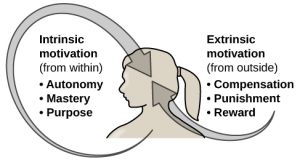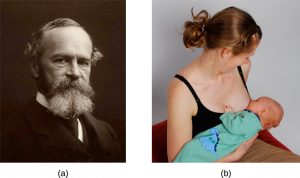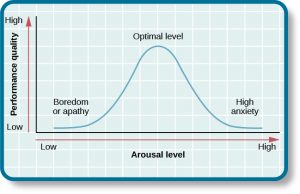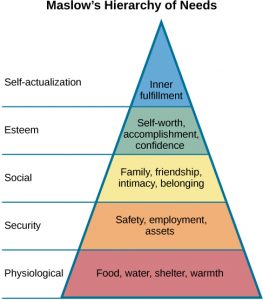11.2 Theories of Motivation
Learning Objectives
- Define intrinsic and extrinsic motivation.
- Understand that instincts, drive reduction, self-efficacy, and social motives have all been proposed as theories of motivation.
- Explain the basic concepts associated with Maslow’s hierarchy of needs.
Why do we do the things we do? What motivations underlie our behaviours? Motivation describes the wants or needs that direct behaviour toward a goal or away from an unpleasant experience. In addition to biological motives, motivations can be intrinsic — arising from internal factors — or extrinsic — arising from external factors (see Figure 11.7). Intrinsically motivated behaviours are performed because of the sense of personal satisfaction that they bring, while extrinsically motivated behaviours are performed in order to receive something from others.

Think about why you are currently in college or university. Are you here because you enjoy learning and want to pursue an education to make yourself a more well-rounded individual? If so, then you are intrinsically motivated. However, if you are here because you want to get a college degree to make yourself more marketable for a high-paying career or to satisfy the demands of your parents, then your motivation is more extrinsic in nature.
In reality, our motivations are often a mix of both intrinsic and extrinsic factors, but the nature of the mix of these factors might change over time, often in ways that seem counter-intuitive. There is an old adage: “Choose a job that you love, and you will never have to work a day in your life,” meaning that if you enjoy your occupation, work doesn’t seem like . . . well, work. Some research suggests that this isn’t necessarily the case (Daniel & Esser, 1980; Deci, 1972; Deci, Koestner, & Ryan, 1999). According to this research, receiving some sort of extrinsic reinforcement (e.g., getting paid) for engaging in behaviours that we enjoy leads to those behaviours being thought of as work no longer providing that same enjoyment. As a result, we might spend less time engaging in these reclassified behaviours in the absence of any extrinsic reinforcement. For example, Odessa loves baking, so in her free time, she bakes for fun. Oftentimes, after stocking shelves at her grocery store job, she often whips up pastries in the evenings because she enjoys baking. When a coworker in the store’s bakery department leaves his job, Odessa applies for his position and gets transferred to the bakery department. Although she enjoys what she does in her new job, after a few months, she no longer has much desire to concoct tasty treats in her free time. Baking has become work in a way that changes her motivation to do it (see Figure 11.8). What Odessa has experienced is called the overjustification effect, which means intrinsic motivation is diminished when extrinsic motivation is given. This can lead to extinguishing the intrinsic motivation and creating a dependence on extrinsic rewards for continued performance (Deci et al., 1999).

Other studies suggest that intrinsic motivation may not be so vulnerable to the effects of extrinsic reinforcements, and in fact, reinforcements such as verbal praise might actually increase intrinsic motivation (Arnold, 1976; Cameron & Pierce, 1994). In that case, Odessa’s motivation to bake in her free time might remain high if, for example, customers regularly compliment her baking or cake-decorating skill.
These apparent discrepancies in the researchers’ findings may be understood by considering several factors. For one, physical reinforcement (e.g., money) and verbal reinforcement (e.g., praise) may affect an individual in very different ways. In fact, tangible rewards (e.g., money) tend to have more negative effects on intrinsic motivation than do intangible rewards (e.g., praise). Furthermore, the expectation of the extrinsic motivator by an individual is crucial. If the person expects to receive an extrinsic reward, then intrinsic motivation for the task tends to be reduced. If, however, there is no such expectation, and the extrinsic motivation is presented as a surprise, then intrinsic motivation for the task tends to persist (Deci et al., 1999).
In educational settings, students are more likely to experience intrinsic motivation to learn when they feel a sense of belonging and respect in the classroom. This internalization can be enhanced if the evaluative aspects of the classroom are de-emphasized and if students feel that they exercise some control over the learning environment. Furthermore, providing students with activities that are challenging, yet doable, along with a rationale for engaging in various learning activities can enhance intrinsic motivation for those tasks (Niemiec & Ryan, 2009). Consider Hakim, a first-year law student with two courses this semester: Family Law and Criminal Law. The Family Law professor has a rather intimidating classroom and likes to put students on the spot with tough questions, which often leaves students feeling belittled or embarrassed; grades are based exclusively on quizzes and exams, and the instructor posts results of each test on the classroom door. In contrast, the Criminal Law professor facilitates classroom discussions and respectful debates in small groups; the majority of the course grade is not exam-based, but instead centres on a student-designed research project on a crime issue of the student’s choice. Research suggests that Hakim will be less intrinsically motivated in his Family Law course, where students are intimidated in the classroom setting, and there is an emphasis on teacher-driven evaluations. Hakim is likely to experience a higher level of intrinsic motivation in his Criminal Law course, where the class setting encourages inclusive collaboration and a respect for ideas, and where students have more influence over their learning activities.
Theories about motivation
William James (1842–1910) was an important contributor to early research into motivation, and he is often referred to as the father of psychology in the United States. James theorized that behaviour was driven by a number of instincts, which aid survival (see Figure 11.9). From a biological perspective, an instinct is a species-specific pattern of behaviour that is not learned. There was, however, considerable controversy among James and his contemporaries over the exact definition of instinct. James proposed several dozen special human instincts, but many of his contemporaries had their own lists that differed. A mother’s protection of her baby, the urge to lick sugar, and hunting prey were among the human behaviours proposed as true instincts during James’s era. This view — that human behaviour is driven by instincts — received a fair amount of criticism because of the undeniable role of learning in shaping all sorts of human behaviour. In fact, as early as the 1900s, some instinctive behaviours were experimentally demonstrated to result from associative learning (Faris, 1921). Recall when you learned about Watson’s conditioning of fear response in “Little Albert.”

According to the drive theory of motivation, deviations from homeostasis create physiological needs. These needs result in psychological drive states that direct behaviour to meet the need and, ultimately, bring the system back to homeostasis. For example, if it’s been a while since you ate, your blood sugar levels will drop below normal. This low blood sugar will induce a physiological need and a corresponding drive state (e.g., hunger) that will direct you to seek out and consume food (see Figure 11.10). Eating will eliminate the hunger, and, ultimately, your blood sugar levels will return to normal. Interestingly, drive theory also emphasizes the role that habits play in the type of behavioural response in which we engage. A habit is a pattern of behaviour in which we regularly engage. Once we have engaged in a behaviour that successfully reduces a drive, we are more likely to engage in that behaviour whenever faced with that drive in the future (Graham & Weiner, 1996).

Extensions of drive theory take into account levels of arousal as potential motivators. As you recall from your study of learning, these theories assert that there is an optimal level of arousal that we all try to maintain (see Figure 11.11). If we are under-aroused, we become bored and will seek out some sort of stimulation. On the other hand, if we are over-aroused, we will engage in behaviours to reduce our arousal (Berlyne, 1960). Most students have experienced this need to maintain optimal levels of arousal over the course of their academic career. Think about how much stress students experience toward the end of spring semester. They feel overwhelmed with seemingly endless exams, papers, and major assignments that must be completed on time. They probably yearn for the rest and relaxation that awaits them over the extended summer break. However, once they finish the semester, it does not take too long before they begin to feel bored. Generally, by the time the next semester is beginning in the fall, many students are quite happy to return to school. This is an example of how arousal theory works.

So, what is the optimal level of arousal? What level leads to the best performance? Research shows that moderate arousal is generally best; when arousal is very high or very low, performance tends to suffer (Yerkes & Dodson, 1908). Think of your arousal level regarding taking an exam for this class. If your level is very low, such as boredom and apathy, your performance will likely suffer. Similarly, a very high level, such as extreme anxiety, can be paralyzing and hinder performance. Consider the example of a softball team facing a tournament. They are favored to win their first game by a large margin, so they go into the game with a lower level of arousal and get beat by a less skilled team.
However, optimal arousal level is more complex than a simple answer that the middle level is always best. Researchers Robert Yerkes and John Dodson (1908) discovered that the optimal arousal level depends on the complexity and difficulty of the task to be performed (see Figure 11.12). This relationship is known as the Yerkes-Dodson law, which holds that a simple task is performed best when arousal levels are relatively high and complex tasks are best performed when arousal levels are lower.

Self-efficacy and social motives
Self-efficacy is an individual’s belief in their own capability to complete a task, which may include a previous successful completion of the exact task or a similar task. Albert Bandura (1994) theorized that an individual’s sense of self-efficacy plays a pivotal role in motivating behaviour. Bandura argues that motivation derives from expectations that we have about the consequences of our behaviours, and ultimately, it is the appreciation of our capacity to engage in a given behaviour that will determine what we do and the future goals that we set for ourselves. For example, if you have a sincere belief in your ability to achieve at the highest level, you are more likely to take on challenging tasks and to not let setbacks dissuade you from seeing the task through to the end.
A number of theorists have focused their research on understanding social motives (McAdams & Constantian, 1983; McClelland & Liberman, 1949; Murray et al., 1938). Among the motives they describe are needs for achievement, affiliation, and intimacy. It is the need for achievement that drives accomplishment and performance. The need for affiliation encourages positive interactions with others, and the need for intimacy causes us to seek deep, meaningful relationships. Henry Murray and colleagues (Murray et al., 1938) categorized these needs into domains. For example, the need for achievement and recognition falls under the domain of ambition. Dominance and aggression were recognized as needs under the domain of human power, and play was a recognized need in the domain of interpersonal affection.
Maslow’s hierarchy of needs
While the theories of motivation described earlier relate to basic biological drives, individual characteristics, or social contexts, Abraham Maslow (1943) proposed that needs are tiered, this became known as Maslow’s hierarchy of needs, which spans the spectrum of motives ranging from the biological to the individual to the social. These needs are often depicted as a pyramid (see Figure 11.13).

At the base of the pyramid are all of the physiological needs that are necessary for survival. These are followed by basic needs for security and safety, the need to be loved and to have a sense of belonging, and the need to have self-worth and confidence. The top tier of the pyramid is self-actualization, which is a need that essentially equates to achieving one’s full potential, and it can only be realized when needs lower on the pyramid have been met. To Maslow and humanistic theorists, self-actualization reflects the humanistic emphasis on positive aspects of human nature. Maslow suggested that this is an ongoing, life-long process and that only a small percentage of people actually achieve a self-actualized state (Francis & Kritsonis, 2006; Maslow, 1943).
According to Maslow (1943), one must satisfy lower-level needs before addressing those needs that occur higher in the pyramid. So, for example, if someone is struggling to find enough food to meet their nutritional requirements, it is quite unlikely that they would spend an inordinate amount of time thinking about whether others viewed them as a good person or not. Instead, all of their energies would be geared toward finding something to eat. However, it should be pointed out that Maslow’s theory has been criticized for its subjective nature and its inability to account for phenomena that occur in the real world (Leonard, 1982). Other research has more recently addressed that late in life. Maslow proposed a self-transcendence level above self-actualization to represent striving for meaning and purpose beyond the concerns of oneself (Koltko-Rivera, 2006). For example, people sometimes make self-sacrifices in order to make a political statement or in an attempt to improve the conditions of others. Mohandas Gandhi, a world-renowned advocate for independence through nonviolent protest, on several occasions went on hunger strikes to protest a particular situation. People may starve themselves or otherwise put themselves in danger displaying higher-level motives beyond their own needs.
Source: Adapted from Spielman et al. (2019).
Key Takeaways
- Motivation describes the wants or needs that direct behaviour toward a goal or away from an unpleasant experience.
- We are intrinsically motivated to pursue goals that make us feel good when we achieve them.
- We are extrinsically motivated to pursue goals with external rewards, like money or recognition.
- William James’s instinct theory of motivation is problematic because it ignores the role of learning.
- The drive theory of motivation predicts that physiological needs result in psychological drive states that direct behaviour to meet the need and bring the system back to homeostasis.
- Physiological arousal is predicted to motivate behaviour. A moderate level of arousal is better for performance than under- or over-arousal, as shown in the Yerkes-Dodson law.
- Several theorists have focused on understanding social motives. The best example is Maslow’s hierarchy of needs that includes a range of needs from physiological to social. Maslow argued that higher needs cannot be met while lower needs are unmet.
- The pinnacle of Maslow’s hierarchy is self-actualization.
Exercises and Critical Thinking
- Schools often use concrete rewards to increase adaptive behaviours. How might this be a disadvantage for students intrinsically motivated to learn? What are educational implications of the potential for concrete rewards to diminish intrinsic motivation for a given task?
Image Attributions
Figure 11.7. Used under a CC BY 4.0 license.
Figure 11.8. Los Bolleros by Agustín Ruiz is used under a CC BY 2.0 license.
Figure 11.9. (a) William James by Notman Studios is in the public domain; (b) DSC_7315 Photo by Al vanAkker is used under a CC BY 2.0 license.
Figure 11.10. Big Bite by Gracie and Viv is used under a CC BY 2.0 license; Girl Eating Sushi by Steven Depolo is used under a CC BY 2.0 license; Old Lady with Sirih by Monica Renata is used under a CC BY 2.0 license.
Figure 11.11. Used under a CC BY 4.0 license.
Figure 11.12. Used under a CC BY 4.0 license.
Figure 11.13. Used under a CC BY 4.0 license.
References
Arnold, H. J. (1976). Effects of performance feedback and extrinsic reward upon high intrinsic motivation. Organizational Behavior and Human Performance, 17, 275–288.
Bandura, A. (1994). Self-efficacy. In V. S. Ramachandran (Ed.), Encyclopedia of human behavior (Vol. 4, pp. 71–81). New York, NY: Academic Press.
Berlyne, D. E. (1960). Toward a theory of exploratory behavior: II. Arousal potential, perceptual curiosity, and learning. In (Series Ed.), Conflict, arousal, and curiosity (pp. 193–227). New York, NY: McGraw-Hill.
Cameron, J., & Pierce, W. D. (1994). Reinforcement, reward, and intrinsic motivation: A meta-analysis. Review of Educational Research, 64, 363–423.
Daniel, T. L., & Esser, J. K. (1980). Intrinsic motivation as influenced by rewards, task interest, and task structure. Journal of Applied Psychology, 65, 566–573.
Deci, E. L. (1972). Intrinsic motivation, extrinsic reinforcement, and inequity. Journal of Personality and Social Psychology, 22, 113–120.
Deci, E. L., Koestner, R., & Ryan, R. M. (1999). A meta-analytic review of experiments examining the effects of extrinsic rewards on intrinsic motivation. Psychological Bulletin, 125, 627–668.
Faris, E. (1921). Are instincts data or hypotheses? American Journal of Sociology, 27, 184–196.
Francis, N. H., & Kritsonis, W. A. (2006). A brief analysis of Abraham Maslow’s original writing of Self-Actualizing People: A Study of Psychological Health. Doctoral Forum National Journal of Publishing and Mentoring Doctoral Student Research, 3, 1–7.
Graham, S., & Weiner, B. (1996). Theories and principles of motivation. In D. C. Berliner & R. C. Calfee (Eds.), Handbook of educational psychology (pp. 63–84). New York, NY: Routledge.
Koltko-Rivera, M. E. (2006). Rediscovering the later version of Maslow’s hierarchy of needs: Self-transcendence and opportunities for theory, research, and unification. Review of General Psychology, 10, 302–317.
Leonard, G. (1982). The failure of self-actualization theory: A critique of Carl Rogers and Abraham Maslow. Journal of Humanistic Psychology, 22, 56–73.
Maslow, A. H. (1943). A theory of human motivation. Psychological Review, 50, 370–396.
McAdams, D. P., & Constantian, C. A. (1983). Intimacy and affiliation motives in daily living: An experience sampling analysis. Journal of Personality and Social Psychology, 45, 851–861.
McClelland, D. C., & Liberman, A. M. (1949). The effect of need for achievement on recognition of need-related words. Journal of Personality, 18, 236–251.
Murray, H. A., Barrett, W. G., Homburger, E., Langer, W. C., Mekeel, H. S., Morgan, C. D., . . . Wolf, R. E. (1938). Explorations in personality: A clinical and experimental study of fifty men of college age. New York, NY: Oxford University Press.
Niemiec, C. P., & Ryan, R. M. (2009). Autonomy, competence, and relatedness in the classroom: Applying self-determination theory to educational practice. Theory and Research in Education, 7, 133–144.
Spielman, R., Dumper, K., Jenkins, W., Lacombe, A., Lovett, M., & Perlmutter, M. (2019). Emotions and motivation. In OpenStax, Psychology. OpenStax CNX. Retrieved from https://cnx.org/contents/Sr8Ev5Og@10.16:UQgvP5NH@9
Yerkes, R. M., & Dodson, J. D. (1908). The relation of strength of stimulus to rapidity of habit-formation. Journal of Comparative Neurology and Psychology, 18, 459–482.

